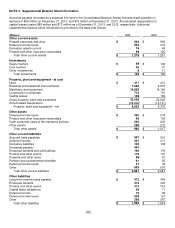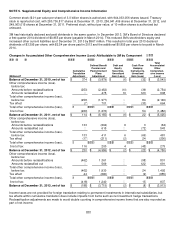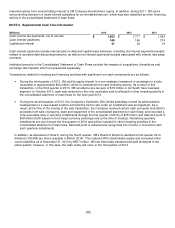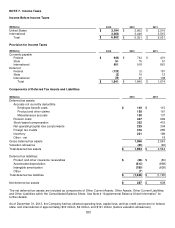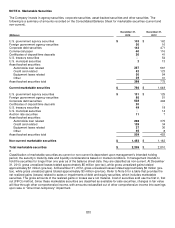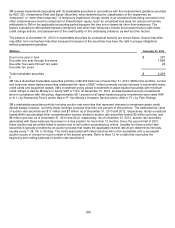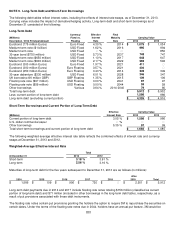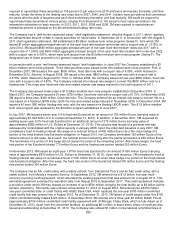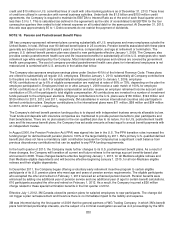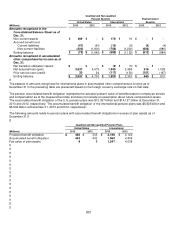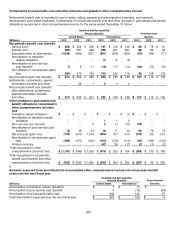3M 2013 Annual Report Download - page 75
Download and view the complete annual report
Please find page 75 of the 2013 3M annual report below. You can navigate through the pages in the report by either clicking on the pages listed below, or by using the keyword search tool below to find specific information within the annual report.
69
respectively. The federal tax attribute carryovers will expire after 16 to 17 years, the state after five to 10 years, and the
majority of international after six years with the remaining international expiring in one year or with an indefinite carryover
period. The tax attributes being carried over arise as certain jurisdictions may have tax losses or may have inabilities to
utilize certain losses without the same type of taxable income. As of December 31, 2013, the Company has provided $23
million of valuation allowance against certain of these deferred tax assets based on management's determination that it is
more-likely-than-not that the tax benefits related to these assets will not be realized. The valuation allowance was reduced
in 2013 mainly due to the expiration of the tax attributes.
During 2013, the Company contributed $476 million to its U.S. and international pension plans and $6 million to its
postretirement plans. During 2012, the Company contributed $1.079 billion to its U.S. and international pension plans and
$67 million to its postretirement plans. During 2011, the Company contributed $517 million to its U.S. and international
pension plans and $65 million to its postretirement plans. The current income tax provision includes a benefit for the
pension contributions; the deferred tax provision includes a cost for the related temporary difference.
Reconciliation of Effective Income Tax Rate
2013 2012
2011
Statutory U.S. tax rate
35.0
%
35.0
%
35.0
%
State income taxes - net of federal benefit
0.9
0.9
0.7
International income taxes - net
(6.3)
(4.2)
(4.6)
U.S. research and development credit
(0.7)
―
(0.5)
Reserves for tax contingencies
1.2
(1.9)
(1.2)
Domestic Manufacturer's deduction
(1.6)
(1.2)
(1.5)
All other - net
(0.4)
0.4
(0.1)
Effective worldwide tax rate
28.1
%
29.0
%
27.8
%
The effective tax rate for 2013 was 28.1 percent, compared to 29.0 percent in 2012, a decrease of 0.9 percentage points,
impacted by many factors. Factors that decreased the Company’s effective tax rate included international taxes as a
result of changes to the geographic mix of income before taxes, the reinstatement of the U.S. research and development
credit in 2013, an increase in the domestic manufacturer’s deduction benefit, the restoration of tax basis on certain assets
for which depreciation deductions were previously limited, and other items. Combined, these factors decreased the
Company’s effective tax rate by 4.0 percentage points. This benefit was partially offset by factors that increased the
effective tax rate by 3.1 percentage points, which largely related to adjustments to 3M’s income tax reserves for 2013
when compared to 2012.
The effective tax rate for 2012 was 29.0 percent, compared to 27.8 percent in 2011, an increase of 1.2 percentage points,
impacted by many factors. The primary factors that increased the Company’s effective tax rate year-on-year include
international taxes, specifically with respect to the corporate reorganization of a wholly owned international subsidiary
(which benefited 2011), state income taxes, lower domestic manufacturer’s deduction, and the lapse of the U.S. research
and development credit. These and other factors, when compared to 2011, increased the 2012 effective tax rate by 2.1
percentage points. Factors that decreased the Company’s effective tax rate year-on-year include international taxes as a
result of changes to the geographic mix of income before taxes and adjustments to its income tax reserves. These factors,
when compared to 2011, decreased the effective tax rate 0.9 percentage points.
The Company files income tax returns in the U.S. federal jurisdiction, and various states and foreign jurisdictions. With few
exceptions, the Company is no longer subject to U.S. federal, state and local, or non-U.S. income tax examinations by tax
authorities for years before 2004.
The IRS completed its field examination of the Company’s U.S. federal income tax returns for the years 2005 through
2007 in the fourth quarter of 2009. The Company protested certain IRS positions within these tax years and entered into
the administrative appeals process with the IRS during the first quarter of 2010. During the first quarter of 2010, the IRS
completed its field examination of the Company’s U.S. federal income tax return for the 2008 year. The Company
protested certain IRS positions for 2008 and entered into the administrative appeals process with the IRS during the
second quarter of 2010. During the first quarter of 2011, the IRS completed its field examination of the Company’s U.S.
federal income tax return for the 2009 year. The Company protested certain IRS positions for 2009 and entered into the
administrative appeals process with the IRS during the second quarter of 2011. During the first quarter of 2012, the IRS
completed its field examination of the Company’s U.S. federal income tax return for the 2010 year. The Company
protested certain IRS positions for 2010 and entered into the administrative appeals process with the IRS during the







